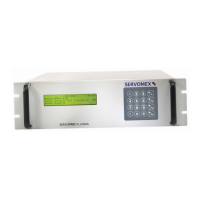User Manual SERVOPRO PLASMA Trace N
2
Analyzer
APPENDIX 1 60
3.0 Regulator purging
Regulator purging is an operation that is not always given the attention it deserves in the use of
both high-purity gases and calibration gases. It is easy to understand that special precautions are
necessary when using theses types of gases.
In order to maintain cylinder integrity and obtain the best results possible, the end user should
purge all regulators. It should be remembered that what happens to the gas between the cylinder
and its end use is controlled by the quality of the connecting lines and the efficiency of the
purging procedure.
Regulator purging is often not done at all, or is done by simply allowing an arbitrary amount of
gas to flow through the regulator. However, there is a shortcoming to this method. In virtually all
regulators, there are internal "dead" pockets which tend to hold contaminants.
The internal "dead" pockets in a regulator tend to be unaffected by the flow of a purge gas. Better
results will be achieved by alternately pressurizing and depressurizing the regulator with the
purge gas. This is called dilution purging, or static purging.
The most effective means of purging connecting lines and regulators is by using the dilution
purging method. The following procedure refers to figure 3. The first step in dilution purging is
to attach the regulator to the specialty gas cylinder. A tee with a valve on the side branch should
then be located in the line between the regulator and the instrument (figure 3). This branch
should be connected to a vent, while the main trunk runs to the instrument.
The second step is to turn the regulator adjustment knob to the fully closed position (fully
clockwise). V1 and V2 must be closed. V1 will stay in the closed position to keep the sample
trap and the line filled with clean gas.
Third, open and quickly close the cylinder valve: that will pressurize the inlet side of the
regulator to cylinder pressure. It is necessary to quickly close the cylinder valve after each cycle
in order to keep downstream contaminants from entering the cylinder until the regulator is fully
purged. Wait approximately one minute, and proceed to the next step.
The fourth step is to open V2 to bleed regulator pressure. To avoid introduction of air do not
depressurize completely. For example, if your pressure regulator has a maximum outlet pressure
of 207 kPa (30 PSI) or 690 kPa (100 PSI), depressurize it to 34 kPa (5 PSI). Then close V2.
Go back to the third step and repeat steps three and four. This cycle should be repeated 7 to 10
times to ensure that the regulator and the connecting line are both properly purged.
When this is done, readjust the outlet pressure of the regulator between 34 kPa (5 PSI) and 69
kPa (10 PSI), venting the excess pressure through V2. Close V2, open V1 and allow flow
through the line into the analyzer.
After this procedure, you should have clean gas in your system, and your calibration gas cylinder
was not polluted by air.

